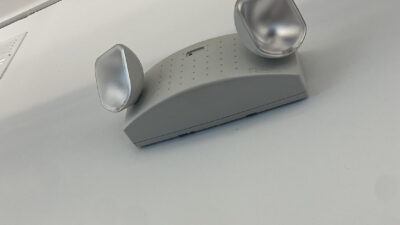Cold calls, noncurrent technical information and pushy salespeople are among the pet peeves of consulting engineers when called on by manufacturer representatives. But vendors can score major points when they offer consistently updated and comprehensive product information on their web sites, educational lunch 'n' learn sessions and timely follow-up and product support.
Cold calls, noncurrent technical information and pushy salespeople are among the pet peeves of consulting engineers when called on by manufacturer representatives. But vendors can score major points when they offer consistently updated and comprehensive product information on their web sites, educational lunch ‘n’ learn sessions and timely follow-up and product support.
Historically, manufacturer representatives and consulting engineers have often had opposing agendas as vendors are interested in selling their product, while an engineer’s goal might be to design building systems that best serve his or her client’s needs. However, it is also true that the two need each other and by combining forces, more of the right systems can be specified for the right applications.
But how can manufacturers best work with engineers?
In our annual survey of major M/E/P engineering firms, Consulting-Specifying Engineer garnered valuable requests and suggestions from engineers. Read on.
Sharing expertise
In general, vendors can be the most helpful to engineers by learning to evaluate overall project considerations, as opposed to simply selling equipment that might not fully serve a building owner’s needs, recommends Thomas J. O’Neill, P.E., president and CEO of Parsons Brinckerhoff, New York.
And according to Elizabeth J. Zipf, marketing manager for the recently renamed Kling, Philadelphia, manufacturers would be best off “listening carefully and responding to what the engineer requests—based on the owner’s requirements—rather than just recommending an off-the-shelf product that is ‘close to’ the stated requirements.”
But because manufacturers possess valuable technical and application information about their products, engineers often rely on vendors to educate them on the pros and cons of a particular unit or system. However, when that individual is overly focused on making the sale, the value of his expertise can be squandered.
“No one knows what equipment can or can’t do better than the manufacturers,” says a senior engineer from TLC , Orlando. “If they would work with us to make the best selection for the project or give us what was specified, rather than try to make a sale, everyone would be better off.”
Melissa Waltman, marketing manager at Princeton, N.J.-based CUH2A even goes so far as to request that companies be honest about the limitations of their equipment and suggest alternatives offered by competitors.
Or, at the very least, Miriam Taylor, corporate marketing manager for C.H. Guernsey & Company, Oklahoma City, says it’s “not so helpful when manufacturers build up their product by putting others down. Just tell me about your product.”
Furthermore, engineers from The RMH Group, Lakewood, Colo., point out that suppliers can be the most convincing when they have real performance data to back up claims of equipment productivity and efficiencies.
Furthermore, shooting straight when it comes to price quotes is another reader request cited often.
Navigating the Web
The web appears to be a great place to start cataloging these suggestions. As a matter of fact, respondents to CSE ‘s survey indicated that web sites are the most preferred way to research new products.
Some web suggestions proffered by John F. Hennessy, III, P.E., chairman and CEO of The Syska Hennessy Group, New York, are:
-
Provide comprehensive product information and operating characteristics.
-
The ability to look at submittals.
-
Access to delivery information.
This last suggestion echoes a preference espoused by the engineers at Kling who stress, “accurate scheduling can make or break some fast-track projects, and equipment delivery is often on the critical path.”
Traditional product delivery methods, however, aren’t completely extinct. Take Miriam Sanders, director of business development for Atkins Benham in Oklahoma City, who states, “Even though the Internet is highly accessible, we still depend upon manufacturers’ catalogs in our library.”
Face to face
One-on-one meetings with manufacturers/suppliers also remains a valuable method for procuring new product information, especially when such seminars are led by the manufacturer’s technical personnel. “Engineers can raise questions and get straight answers regarding new product claims and appropriate applications,” says Kling’s Zipf.
Furthermore, according to Michelle T. Miles, a vice president with Hayes, Seay, Mattern & Mattern, Roanoke, Va., engineers particularly appreciate these individuals when they either come from an engineering background or possess a good working knowledge of the world of consulting engineering. In such cases, Miles says that manufacturers are best equipped to understand the engineer’s challenge and offer valuable assistance.
Can I help you?
Another key point for manufacturers to consider is the fact that engineers, today, must deal with increased client demands and expectations of response time. Thus, “some of the most helpful ways manufacturers and suppliers can work with engineers are increasing the accessibility of their staff and providing faster response time on issues of equipment selection and support,” notes Donald L. Beaty, P.E., CEO, DLB Associates, Wanamassa, N.J.
A couple of additional suggestions offered by Ronald W. Mineo, P.E., chief mechanical engineer, Joseph R. Loring & Associates, New York, include:
-
Informing the engineers of changing codes and standards that necessitate a change in equipment performance.
-
Informing engineers of new technologies that develop.
-
Explaining how the technology is applied with their equipment.
Finally, even though manufacturers may be weary of nudging engineers too much, the engineer may, in fact, have a need for such products, but this won’t necessarily be known unless manufacturers make an effort to find out.
Take Lizardos Engineering Associates in Meneloa, N.Y. According to Lewis M. Damrauer, P.E., the firm’s chief electrical engineer, “We are a large company in the suburbs of a large metropolitan area. We find that we have to stay on top of vendor’s representatives, rather than them staying on top of us. We would like the manufacturers to stay in touch with us more frequently.”
Go to the Web
When Washington Group International, a large design and construction firm based in Boise, Idaho, traded in its hardcopy engineering specifications, standards and vendor catalogs for Internet-based electronic documents, the firm’s library costs decreased by 60%.
Consolidated under two web services—the Specs and Standards Service and CatalogXpress—Washington Group standards, specifications and catalogs can be accessed through the company’s intranet.
The first service contains more than 347,000 actual standards documents from more than 450 standards-developing organizations worldwide, and CatalogXpress provides full-text catalogs from more than 9,000 vendors.
Beside library cost savings, the immediacy of information the system provides has already provided big dividends.
For example, during a test run of a boiler in the United Kingdom, a problem occurred with the equipment. Unfortunately, it was the middle of the night in the United States, so it was impossible to contact the manufacturer. As the boiler pressure began building to costly high levels, it was clear that certain valves needed to be opened, or costly damage would be incurred.
“The engineers needed to find the standard that told them how the valve was connected and how to use it to relieve the pressure,” recalls Darla Wagner, head librarian for Washington Group’s Power unit. “They also wanted to contact the vendor of the valve. However, they couldn’t wait a few hours for the librarian to come in to work.”
Fortunately, through these on-line document services, the engineers found what they needed in time to prevent the boiler from being damaged.
To view a full article describing the Washington Group’s use of these on-line services, see the Deep Links section of CSE’s November issue, at:



